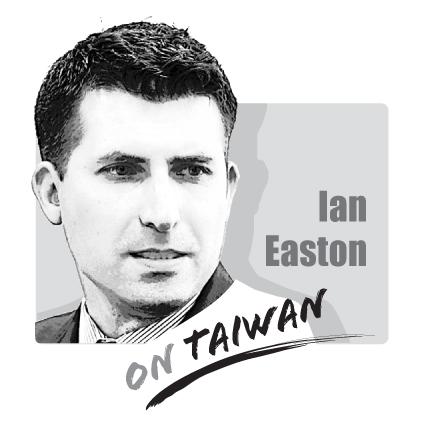In September 2013, the armed wing of the Chinese Communist Party (CCP) quietly released an internal document entitled, “Coursebook on the Military Geography of the Taiwan Strait.” This sensitive, “military-use-only” coursebook explains why it is strategically vital that China “reunify” (annex) Taiwan. It then methodically analyzes various locations of interest to People’s Liberation Army (PLA) war planners.
The coursebook highlights one future battlefield in particular: Fulong Beach, in New Taipei City’s Gongliao District, which it describes as “3,000 meters long, flat, and straight,” and located at “the head of Taiwan.” A black and white picture of Fulong’s sandy coastline occupies the lion’s share of the next page. The book has numerous aerial photos of Taiwan’s ports, cities, and river deltas. But this is the only potential invasion beach readers have the chance to admire. In fact, it’s the largest single image in the entire book.
Yet for all the attention lavished on Fulong Beach, the PLA coursebook overlooks something critical. At the north end of the beach, lurking just outside the picture, is Taiwan’s 4th Nuclear Power Plant. Today, this massive seaside complex of white and red block structures sits idle. In 2014, construction was put on hold due to safety concerns. The plant’s future remains suspended in limbo, but a referendum this coming summer might finally seal its fate. Yet if it seems unlikely that Taiwan’s 4th Nuclear Power Plant will be splitting atoms on a future invasion day, the same cannot be said of its brother facility.

The PLA coursebook also draws attention to a potential invasion beach in New Taipei City’s Jinshan District: Xialiao Beach. Located next to Yehliu Geopark, a tourist hotspot known for its otherworldly rock formations, Xialiao Beach plays host to Taiwan’s 2nd Nuclear Power Plant, an active facility with two powerful reactors.
According to Rene Vienet, an expert on Taiwan’s nuclear power infrastructure, the 2nd Nuclear Power Plant has two over-saturated waste pools, which were not designed for the long-term storage of spent fuel. The government of France nixed a pre-existing plan to recycle the dangerous material, and Taipei has been unable to find a politically-viable alternative.
The plant and its radioactive waste are omitted from the PLA coursebook’s description of the beach and its surrounding area. Why?
If PLA planners were really considering amphibious landings near Taiwanese nuclear power plants, something that might result in a radioactive nightmare, wouldn’t they want to take precautions? The answer, it appears, is yes.
In 2014, a team of military experts at the Nanjing Army Command Academy produced an internal field manual on the use of helicopters in Taiwan attack operations. According to this source, Taiwan’s nuclear power plants represent high-value military targets, but they are also politically sensitive and could be important for power generation after Taiwan is occupied.
The field manual advises PLA combat commanders to abstain from using heavy firepower (like ballistic missiles) against Taiwan’s reactors. Instead, the manual argues helicopter gunships armed with anti-tank missiles should be given the mission of hitting them. By using smaller rounds capable of precision strikes, the document argues Taiwan’s nuclear power plants could be knocked offline without totally destroying them (that way they can be turned back on again after the war). At least, that’s the theory. Other sources are not so optimistic.
In 2015, the PLA released an updated copy of “Informatized Army Operations,” a textbook for ground force commanders that includes a detailed section on what they should expect during a future invasion of Taiwan. This source notes that Chinese combat units could have to fight through areas of “nuclear, biological, and chemical contamination” as they push off the beaches and into the depths of Taiwan. It does not specify the origin of the envisioned contamination.
Another how-to-invade-Taiwan manual published by the Nanjing Army Command Academy in 2015 similarly warns of “poisonous contamination zones” near ports. Both Fulong and Xialiao beaches are near Keelung, the largest port city in northern Taiwan.
One plausible explanation for the pessimism of PLA researchers is that they believe Taiwan’s nuclear power plants could meltdown in the course of fighting.
We cannot say for sure how the PLA plans to deal with a radiological disaster. The available materials do not dwell at length on this particular problem. The terse guidance would-be invaders get regarding fallout on Taiwan is essentially, “wash it off and don’t let it slow you down as you finish conquering the island.”
And there’s another problem: our sources are old. Since 2015, the PLA has introduced an array of new weapons and tactics aimed at Taiwan. Unfortunately, the CCP’s security services have also clamped down on the flow of information to the outside world.
How might the availability of stealth attack drones, AI-enabled cyber weapons, and engineered biological agents change Beijing’s future plans? What about undercover agents and special forces saboteurs? Without access to current materials, we can only guess.
It seems prudent to assume that Taiwan’s nuclear power plants will remain PLA targets until they are fully deactivated. However, we should be careful not to lose our sense of proportion. As horrifying as the specter of possible strikes on nuclear plants might be, they would pale comparison to the overall picture of invasion and great power war.
Because the threat of invasion is increasingly credible, Washington and Taipei should treat this scenario with the urgency it warrants. To this end, the United States could reestablish a Military Assistance Advisory Group in Taiwan, begin regular bilateral military exercises in the Western Pacific, and send the appropriate four-star admirals and generals to Taiwan so that they can familiarize themselves with the battlespace.
For its part, Taiwan could invest in an emergency stockpiling effort, make a tenfold increase in reserve force training days, and mass produce thousands of counterstrike missiles for neutralizing targets in the People’s Republic of China.
Internal PLA documents show that a future invasion of Taiwan won’t look like D-Day. It will be far more sophisticated and complex. And it could go nuclear.
The US and Taiwan would do well to plan accordingly.
Ian Easton is Senior Director at the Project 2049 Institute and author of The Chinese Invasion Threat.

Taiwan stands at the epicenter of a seismic shift that will determine the Indo-Pacific’s future security architecture. Whether deterrence prevails or collapses will reverberate far beyond the Taiwan Strait, fundamentally reshaping global power dynamics. The stakes could not be higher. Today, Taipei confronts an unprecedented convergence of threats from an increasingly muscular China that has intensified its multidimensional pressure campaign. Beijing’s strategy is comprehensive: military intimidation, diplomatic isolation, economic coercion, and sophisticated influence operations designed to fracture Taiwan’s democratic society from within. This challenge is magnified by Taiwan’s internal political divisions, which extend to fundamental questions about the island’s identity and future
The narrative surrounding Indian Prime Minister Narendra Modi’s attendance at last week’s Shanghai Cooperation Organization (SCO) summit — where he held hands with Russian President Vladimir Putin and chatted amiably with Chinese President Xi Jinping (習近平) — was widely framed as a signal of Modi distancing himself from the US and edging closer to regional autocrats. It was depicted as Modi reacting to the levying of high US tariffs, burying the hatchet over border disputes with China, and heralding less engagement with the Quadrilateral Security dialogue (Quad) composed of the US, India, Japan and Australia. With Modi in China for the
The Chinese Nationalist Party (KMT) has postponed its chairperson candidate registration for two weeks, and so far, nine people have announced their intention to run for chairperson, the most on record, with more expected to announce their campaign in the final days. On the evening of Aug. 23, shortly after seven KMT lawmakers survived recall votes, KMT Chairman Eric Chu (朱立倫) announced he would step down and urged Taichung Mayor Lu Shiow-yen (盧秀燕) to step in and lead the party back to power. Lu immediately ruled herself out the following day, leaving the subject in question. In the days that followed, several
The Jamestown Foundation last week published an article exposing Beijing’s oil rigs and other potential dual-use platforms in waters near Pratas Island (Dongsha Island, 東沙島). China’s activities there resembled what they did in the East China Sea, inside the exclusive economic zones of Japan and South Korea, as well as with other South China Sea claimants. However, the most surprising element of the report was that the authors’ government contacts and Jamestown’s own evinced little awareness of China’s activities. That Beijing’s testing of Taiwanese (and its allies) situational awareness seemingly went unnoticed strongly suggests the need for more intelligence. Taiwan’s naval